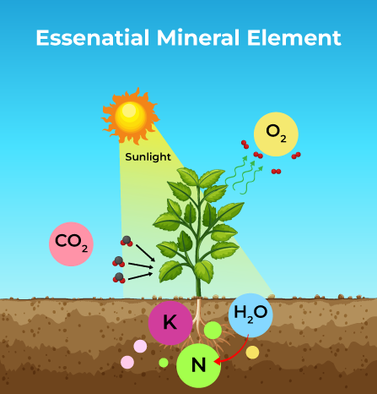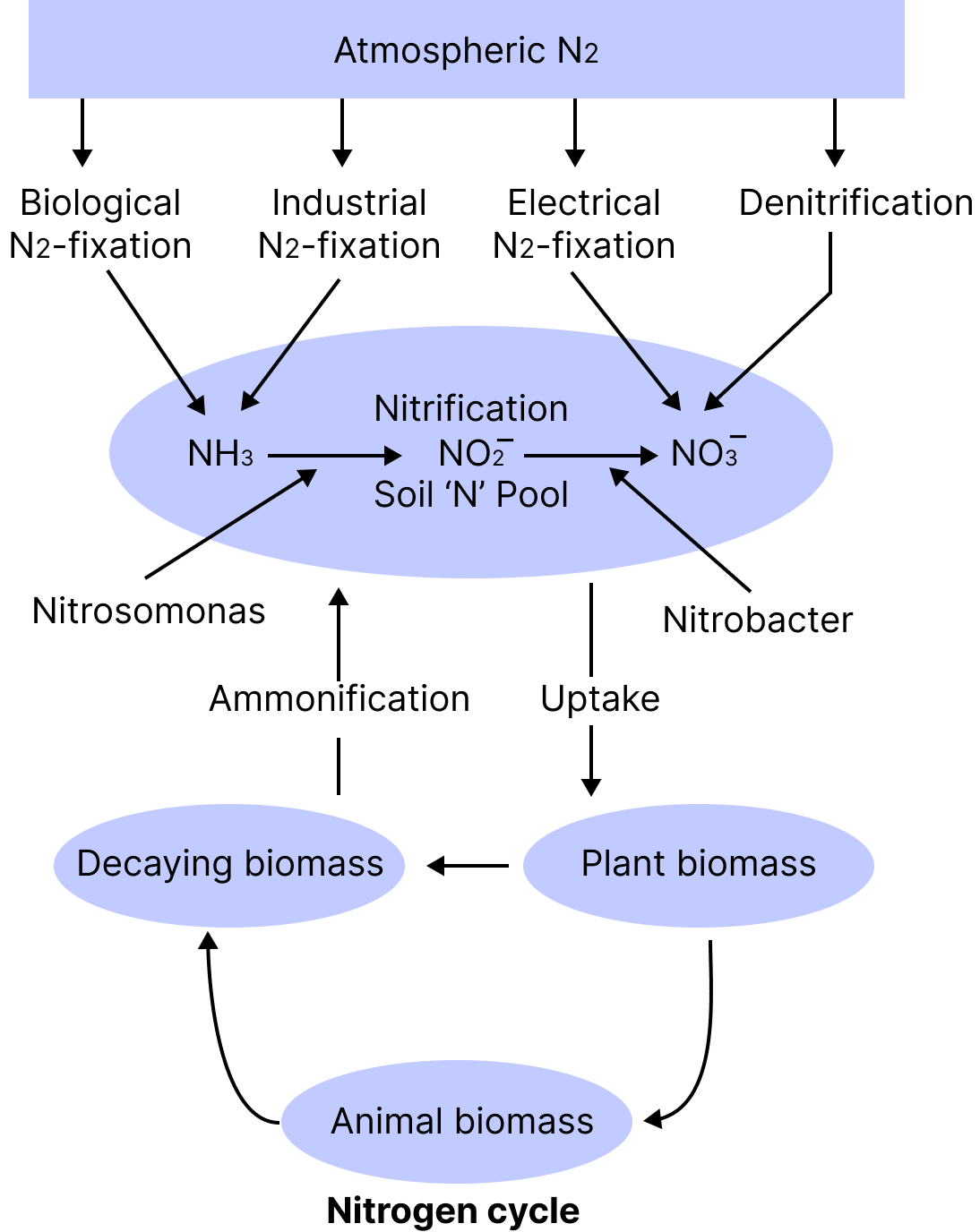




Understanding Mineral Nutrition and Its Role in Plant and Animal Health
Mineral Nutrition refers to the absorption and utilisation of essential minerals by both plants and animals. These minerals are naturally occurring inorganic substances found in the soil and food, playing a crucial role in various biological processes. Minerals are indispensable for maintaining health, growth, and proper functioning of the body, whether it is a plant or an animal. For example, zinc is essential for protein synthesis and cell division, making it vital for both plant and animal growth.
In this article, we will explore the two main categories of nutrients – macronutrients and micronutrients – and discuss their roles in supporting life processes in both plants and animals.

Types of Nutrients
Macronutrients
These are nutrients required by plants in larger quantities. They include-Nitrogen (N)- A key component of proteins, nucleic acids, and chlorophyll, nitrogen is essential for plant growth. It helps in the synthesis of important compounds like amino acids and enzymes, and its deficiency leads to impaired growth, yellowing of leaves, and stunted development.
Phosphorus (P)- Phosphorus aids in energy transfer and is critical for the formation of DNA and RNA. It promotes healthy root growth and fruit development. A phosphorus deficiency can result in poor root development, purpling of leaves, and delayed flowering.
Potassium (K) - Potassium is essential for enzyme activation, including DNA polymerase. It helps regulate water balance in plants and enhances disease resistance. Deficiency in potassium causes mottled chlorosis (yellowing) of leaves and weak stems.
Calcium (Ca)- Calcium strengthens cell walls and is involved in cell division. It also helps in the functioning of certain enzymes. Without sufficient calcium, plants may exhibit poor root growth and weak stems.
Magnesium (Mg)- Magnesium is the central atom in chlorophyll, the molecule responsible for photosynthesis. It helps in the absorption of light energy and the production of carbohydrates.
Sulphur (S)- Sulphur is essential for the synthesis of amino acids and proteins. It helps in the formation of chlorophyll and contributes to the plant’s resistance to disease.
Micronutrients
These nutrients are required in smaller amounts but are just as vital for plant and animal health. They include-
Iron (Fe)- Iron is a key component of enzymes involved in electron transport during photosynthesis and respiration. It is vital for chlorophyll synthesis.
Zinc (Zn)- Zinc plays a role in enzyme activation, protein synthesis, and plant growth. It helps in the metabolism of carbohydrates and phosphorus, and its deficiency results in reduced leaf size and stunted plant growth.
Copper (Cu)- Copper is involved in photosynthesis and acts as a catalyst in the formation of certain enzymes. It also plays a role in iron absorption.
Manganese (Mn)- Manganese is involved in the photolysis of water during photosynthesis. It helps in the formation of chlorophyll and regulates several enzyme systems.
Boron (B)- Boron plays a role in cell wall formation, nutrient transport, and seed development. It is essential for the formation of reproductive structures in plants.
Molybdenum (Mo)-Molybdenum is involved in the nitrogen fixation process in legumes and the reduction of nitrate to ammonia in plants.

Roles of Minerals in Plants and Animals Health
Balancing Functions- Certain minerals balance the harmful effects of other nutrients. For example, calcium counteracts the toxic effects of excessive potassium.
Maintenance of Osmotic Pressure- Minerals like potassium and sodium regulate the osmotic pressure within plant cells, ensuring proper hydration and nutrient flow.
Influencing pH Levels- Anions and cations in plant cells affect the pH of cell sap, influencing biochemical processes such as enzyme activation and nutrient absorption.
Construction of Plant Structures- Carbon, hydrogen, and oxygen, along with minerals like nitrogen and phosphorus, are key components in building plant tissues and structures like leaves, stems, and roots.
Catalysing Biochemical Reactions- Elements such as magnesium, zinc, and copper act as metallic catalysts in a variety of biochemical reactions within plant and animal bodies.
Toxicity Effects- Some minerals, like arsenic and copper, can be toxic when present in excess, leading to cellular damage and impairing the organism's normal functions.
Unique Aspects of Mineral Nutrition
1. Phytoremediation- Plants have evolved unique mechanisms to absorb and detoxify harmful minerals from the soil, a process known as phytoremediation. Certain plants can accumulate heavy metals like lead and mercury, which is beneficial for cleaning polluted environments.
2. Mineral Deficiency and Toxicity Symptoms- Different minerals show distinct deficiency or toxicity symptoms in plants. For example, magnesium deficiency leads to interveinal chlorosis, while nitrogen deficiency causes a yellowing of older leaves.
Quiz- Test Your Knowledge of Mineral Nutrition
Which nutrient is vital for photosynthesis? a) Nitrogen
b) Magnesium
c) Phosphorus
d) Potassium
Answer- b) MagnesiumWhat is the primary role of phosphorus in plants? a) Formation of chlorophyll
b) Energy transfer and root growth
c) Water regulation
d) Synthesis of proteins
Answer- b) Energy transfer and root growthWhat happens when a plant lacks nitrogen? a) Stunted growth and yellowing of leaves
b) Poor root development
c) Reduced photosynthesis
d) Weak stems
Answer- a) Stunted growth and yellowing of leaves
Related Topics-
Essential Study Materials for NEET UG Success
FAQs on Mineral Nutrition- Vital Nutrients for Healthy Growth in Plants and Animals
1. What are the symptoms of mineral deficiencies in plants?
Plants exhibit various signs such as yellowing of leaves, poor growth, wilting, or stunted development depending on which mineral is deficient.
2. Can mineral imbalances harm plants?
Yes, both deficiencies and excesses of minerals can harm plants. An imbalance can lead to poor growth, tissue damage, or even plant death.
3. How do plants absorb minerals from the soil?
Plants absorb minerals through their roots in the form of ions, which are then transported to different parts of the plant.
4. What is the role of potassium in plants?
Potassium plays a crucial role in enzyme activation, particularly those involved in protein synthesis and starch formation. It also helps regulate water movement within plants, maintaining turgor pressure and supporting disease resistance. Potassium deficiency can lead to mottled chlorosis (yellowing of leaves) and weak stems.
5. How can we prevent mineral deficiencies in plants?
To prevent mineral deficiencies, it is essential to provide plants with a balanced fertilisation regime that includes the necessary macronutrients and micronutrients. Using organic compost, mineral-rich fertilisers, and ensuring proper soil pH and drainage can also help maintain healthy mineral levels in the soil.
6. What happens if there is an excess of minerals in plants?
Excess minerals can be harmful to plants, causing toxicity. For example, too much nitrogen can result in excessive leaf growth at the expense of flowers and fruit, while too much potassium can affect the plant's ability to absorb other important nutrients like calcium and magnesium.
7. Why do plants need magnesium?
Magnesium is the central atom in the chlorophyll molecule, which is essential for photosynthesis. It helps plants absorb light energy and convert it into chemical energy. Magnesium deficiency can result in chlorosis, where the plant’s leaves turn yellow due to reduced chlorophyll production.
8. Can minerals affect plant reproduction?
Yes, minerals like phosphorus and boron are critical for reproductive processes in plants. Phosphorus supports flower and seed formation, while boron is vital for pollen tube formation and seed development.
9. How do micronutrients help plants?
Micronutrients, although required in small amounts, are essential for enzyme activation, growth regulation, and maintaining plant health. For example, copper is involved in photosynthesis, while zinc plays a role in protein synthesis and growth regulation.
10. What is the impact of nitrogen deficiency on plants?
Nitrogen deficiency can lead to stunted growth, yellowing of older leaves (chlorosis), and poor root development. It can also cause plants to be more susceptible to diseases and pests, as nitrogen is a crucial component of proteins and chlorophyll.
11. Can plants absorb minerals through their leaves?
Yes, some minerals can be absorbed through the leaves, especially if they are sprayed in a water-soluble form. However, the primary mode of nutrient absorption for plants is through their roots from the soil.
12. What are the effects of iron deficiency in plants?
Iron deficiency causes chlorosis, particularly between leaf veins. The leaves turn yellow while the veins remain green. Iron is necessary for the production of chlorophyll and is involved in electron transport during photosynthesis.
13. Can plants survive without micronutrients?
While plants can survive with low levels of micronutrients, they cannot thrive or grow properly without them. Micronutrients are vital for various enzymatic functions and metabolic processes that are critical for plant development and reproduction.
14. How can I identify if a plant is lacking a specific nutrient?
Each nutrient deficiency causes distinct symptoms in plants. For example, nitrogen deficiency results in yellowing of older leaves, phosphorus deficiency causes dark green or purplish leaves, and potassium deficiency results in mottled chlorosis. Observing these symptoms can help identify nutrient deficiencies.









